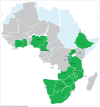Implementation of the World Health Organization Regional Office for Africa Stepwise Laboratory Quality Improvement Process Towards Accreditation
- PMID: 28879103
- PMCID: PMC5436392
- DOI: 10.4102/ajlm.v5i1.280
Implementation of the World Health Organization Regional Office for Africa Stepwise Laboratory Quality Improvement Process Towards Accreditation
Abstract
Background: The increase in disease burden has continued to weigh upon health systems in Africa. The role of the laboratory has become increasingly critical in the improvement of health for diagnosis, management and treatment of diseases. In response, the World Health Organization Regional Office for Africa (WHO AFRO) and its partners created the WHO AFRO Stepwise Laboratory (Quality) Improvement Process Towards Accreditation (SLIPTA) program.
Slipta implementation process: WHO AFRO defined a governance structure with roles and responsibilities for six main stakeholders. Laboratories were evaluated by auditors trained and certified by the African Society for Laboratory Medicine. Laboratory performance was measured using the WHO AFRO SLIPTA scoring checklist and recognition certificates rated with 1-5 stars were issued.
Preliminary results: By March 2015, 27 of the 47 (57%) WHO AFRO member states had appointed a SLIPTA focal point and 14 Ministers of Health had endorsed SLIPTA as the desired programme for continuous quality improvement. Ninety-eight auditors from 17 African countries, competent in the Portuguese (3), French (12) and English (83) languages, were trained and certified. The mean score for the 159 laboratories audited between May 2013 and March 2015 was 69% (median 70%; SD 11.5; interquartile range 62-77). Of these audited laboratories, 70% achieved 55% compliance or higher (2 or more stars) and 1% scored at least 95% (5 stars). The lowest scoring sections of the WHO AFRO SLIPTA checklist were sections 6 (Internal Audit) and 10 (Corrective Action), which both had mean scores below 50%.
Conclusion: The WHO AFRO SLIPTA is a process that countries with limited resources can adopt for effective implementation of quality management systems. Political commitment, ownership and investment in continuous quality improvement are integral components of the process.
Conflict of interest statement
The authors declare that they have no financial or personal relationship(s) that may have inappropriately influenced them in writing this article.
Figures
Similar articles
-
Impact of mentorship on WHO-AFRO Strengthening Laboratory Quality Improvement Process Towards Accreditation (SLIPTA).Afr J Lab Med. 2012 Feb 16;1(1):6. doi: 10.4102/ajlm.v1i1.6. eCollection 2012. Afr J Lab Med. 2012. PMID: 29062726 Free PMC article.
-
Piloting laboratory quality system management in six health facilities in Nigeria.PLoS One. 2014 Dec 26;9(12):e116185. doi: 10.1371/journal.pone.0116185. eCollection 2014. PLoS One. 2014. PMID: 25542022 Free PMC article.
-
Examining 7 years of implementing quality management systems in medical laboratories in sub-Saharan Africa.Trop Med Int Health. 2023 Feb;28(2):126-135. doi: 10.1111/tmi.13839. Epub 2022 Dec 14. Trop Med Int Health. 2023. PMID: 36480459 Free PMC article.
-
Strengthening national health laboratories in sub-Saharan Africa: a decade of remarkable progress.Trop Med Int Health. 2014 Apr;19(4):450-8. doi: 10.1111/tmi.12269. Epub 2014 Feb 10. Trop Med Int Health. 2014. PMID: 24506521 Free PMC article. Review.
-
Strengthening Laboratory Management Toward Accreditation, A Model Program for Pathology Laboratory Improvement.Clin Lab Med. 2018 Mar;38(1):131-140. doi: 10.1016/j.cll.2017.10.010. Epub 2017 Dec 19. Clin Lab Med. 2018. PMID: 29412877 Review.
Cited by
-
Review of the Stepwise Laboratory Quality Improvement Process Towards Accreditation (SLIPTA) version 2:2015.Afr J Lab Med. 2020 Oct 28;9(1):1068. doi: 10.4102/ajlm.v9i1.1068. eCollection 2020. Afr J Lab Med. 2020. PMID: 33240798 Free PMC article.
-
Clinical Referral Laboratory Personnel's Perception of Challenges and Strategies for Sustaining the Laboratory Quality Management System.Am J Clin Pathol. 2019 Nov 4;152(6):725-734. doi: 10.1093/ajcp/aqz092. Am J Clin Pathol. 2019. PMID: 31304959 Free PMC article.
-
Practical recommendations for strengthening national and regional laboratory networks in Africa in the Global Health Security era.Afr J Lab Med. 2016 Oct 31;5(3):471. doi: 10.4102/ajlm.v5i3.471. eCollection 2016. Afr J Lab Med. 2016. PMID: 28879137 Free PMC article.
-
Harmonization of four biomarkers across nine nationally representative studies of older persons.Am J Hum Biol. 2024 May;36(5):e24030. doi: 10.1002/ajhb.24030. Epub 2023 Dec 9. Am J Hum Biol. 2024. PMID: 38069621 Free PMC article.
-
Clinical Referral Laboratories in Rwanda.Am J Clin Pathol. 2018 Jul 31;150(3):240-245. doi: 10.1093/ajcp/aqy047. Am J Clin Pathol. 2018. PMID: 29931081 Free PMC article.
References
-
- Boutayeb A. The impact of infectious diseases on the development of Africa In: Preedy VR, Watson RR, editors. Handbook of disease burdens and quality of life measures. New York: Springer Science+Business Media, LLC., 2010; p. 1171–1188.
-
- Nkengasong JN. Strengthening laboratory services and systems in resource-poor countries. Am J Clin Pathol. 2009;131(6):774 http://dx.doi.org/10.1309/AJCP8GYX8KTKDATZ - DOI - PubMed
-
- Burgess DCH, Wasserman J, Dahl CA. Global health diagnostics. Nature. 2006;444(Suppl 1):1–2. http://dx.doi.org/10.1038/nature05440 - DOI - PubMed
-
- Peter TF, Rotz PD, Blair DH, et al. . Impact of laboratory accreditation on patient care and the health system. Am J Clin Pathol. 2010;134(4):550–555. http://dx.doi.org/10.1309/AJCPH1SKQ1HNWGHF - DOI - PubMed
-
- Fu E, Yager P, Floriano PN, et al. . Perspective on diagnostics for global health. IEEE Pulse. 2011;2(6):40–50. http://dx.doi.org/10.1109/MPUL.2011.942766 - DOI - PMC - PubMed
Grants and funding
LinkOut - more resources
Full Text Sources
Other Literature Sources



